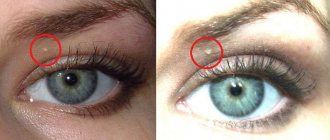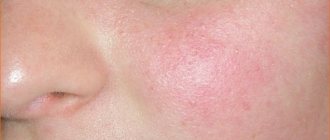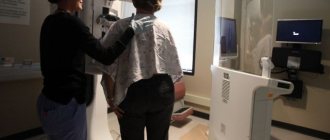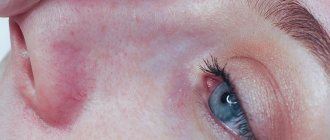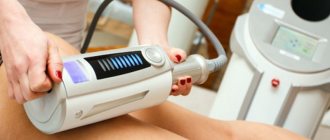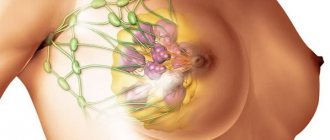In the medical literature there are various definitions of lipoatrophy syndrome, or lipodystrophy. This term combines heterogeneous acquired or congenital pathological conditions, common to which are abnormal changes in adipose tissue in combination with laboratory signs of disorders, mainly lipid metabolism, and in some forms without laboratory symptoms.
…
General concept of pathology
Pathological conditions of the body and the development of subcutaneous fat can be expressed in the following forms:
- Atrophic, which consists of loss of subcutaneous tissue volume in selective areas of the body. In this case, destruction of muscle tissue with a decrease in its mass, in contrast to ordinary dystrophic changes in the body, does not occur. Lipodystrophy of the face, limbs and buttocks is especially pronounced. Facial lipoatrophy occurs in many older people, but, unlike a pathological condition, it is a cosmetic drawback, since it is associated with age-related tissue degradation, including adipose tissue.
- Hypertrophic, the meaning of which is the excessive accumulation of adipose tissue in such parts of the body as the abdomen, mammary glands, back of the neck and upper back, sometimes muscles and liver.
- Combined - depletion of adipose tissue in some areas of the body and its accumulation in others.
These clinical signs often have much in common with complex metabolic disorders, for example, with resistance to the influence of insulin in the liver and peripheral tissues, impaired resistance of the latter to glucose with the possible development of type 2 diabetes mellitus, with an increase in the blood levels of triglycerides, cholesterol with a predominance of an increase in low lipoproteins and very low density. Sometimes deviations from normal laboratory parameters precede clinical symptoms. At the same time, metabolic changes reach their greatest severity among patients who also have a pronounced clinical picture.
Of course, metabolic syndrome is combined with visceral weight gain, but, although this is paradoxical, loss of fat volume (lipodystrophy) can also be accompanied by metabolic disorders. They are similar to those in metabolic syndrome, that is, they are accompanied by an increase in the level of free fatty acids and liver synthesis of very low-density lipoproteins, accumulation of fat in muscles, fatty liver, tissue insulin resistance, increased risk of cardiovascular pathology, etc.
Manifestations of lipoatrophy in diabetic patients
Symptoms of "widow's hump":
- neck pain, feeling of severe tension;
- stooping, forced unnatural position of the head;
- specific crunches and clicks when turning the head;
- decreased sensitivity and numbness of the neck muscles;
- dizziness and headache;
- pressure surges;
- fatigue and drowsiness.
Symptoms usually appear when an aesthetic problem becomes a physiological one. The neoplasm occurs between the skin and muscle tissue and is visually similar to a mound.
There are no clinical signs of the disease, but if the “wen” is left unattended, it will continue to grow. Due to excessive accumulation of dense fat and poor posture, changes in muscle tone develop (muscle-tonic syndrome), which subsequently leads to obstruction of blood flow to the brain.
Manifestations of lipodystrophy and causes of development
In accordance with the type of distribution of changes in adipose tissue in the body, lipodystrophies are divided into partial (segmental), generalized, limited (local), and depending on the reasons, which are not always possible to establish, they are divided into:
- Purchased
- Hereditary
Each type of pathological condition is characterized by a specific development mechanism and clinical picture.
Acquired forms of the disease
Partial lipodystrophy in people infected with human immunodeficiency virus (HIV)
It is currently the most common type of pathology under consideration. The incidence of the latter among these patients is 10-80%. This “dispersion” of frequency indicators is associated with the age of patients, the state of the body preceding the disease, the level of immunosuppression, and the type and duration of treatment with antiretroviral drugs. All of them have the property of causing certain phenomena of lipodystrophy, but their nature and severity are different.
Facial lipodystrophy in an HIV patient
For example, atrophy of adipose tissue during the treatment of HIV-infected patients is explained mainly by the influence of Stavudine, Zinovudine and some other drugs that are nucleoside analogues of chemical compounds that inhibit the enzyme revertase. Disorders of lipid metabolism are possible as a result of taking almost any of the antiretroviral drugs, but still more often in individuals who receive therapeutic regimens that include protease inhibitors. The latter contribute to the development of insulin resistance and, accordingly, an increased risk of developing diabetes, which, in turn, aggravates metabolic disorders. However, the specific mechanisms that contribute to the development of lipoatrophy during treatment with drugs that are protease inhibitors have not been elucidated.
HIV-infected individuals very often develop lipoatrophy of the face, upper and lower extremities. These changes can sometimes be combined with excess deposition of body fat (in the back of the neck and upper back), its redistribution against the background of general body weight loss, impaired liver function, lactic acidosis and ascites (fluid in the abdominal cavity). But at the same time, excessive concentrations of insulin and lipids in the blood are quite rare.
Correction of facial volume in an HIV patient by administering calcium hydroxyapatite (Radiesse)
Barraquer-Simons syndrome
Or segmental, progressive lipodystrophy. In terms of frequency, it ranks second among acquired partial forms of this pathology. It occurs in a complete or incomplete form (only in the upper half of the body). Women get sick 4 times more often. The incomplete form occurs mainly in men.
The disease develops in childhood or adolescence. It is characterized by the disappearance of subcutaneous fatty tissue mainly in the face, neck, upper chest, upper extremities, and pit of the stomach. At the same time, it is possible, especially in women, to increase the volume of adipose tissue in the lower parts of the anterior abdominal wall, lumbar region, buttocks and thighs. Tissue resistance to insulin and associated complications are extremely rare. Approximately 8 years from the onset of the disease, 20% of patients develop membranoproliferative glomerulonephritis.
The cause of the pathology has not been established. The possibility of dysfunction of the hypothalamus of the brain, thyroid gland, etc. is assumed. But preference is given to autoimmune etiology. Often, patients with this pathology also develop autoimmune diseases such as juvenile dermatomyositis and systemic lupus erythematosus.
Acquired generalized form
Or Lawrence syndrome. It is rare (only 80 cases have been described, of which the male gender is about 33%). Loss of subcutaneous fat, as in the previous case, occurs in childhood or adolescence, less often in middle age. This occurs in large areas, mainly of the face and limbs, less often in the area of the palms and feet and, as a rule, bone marrow adipose tissue and retro-orbital adipose tissue are preserved. The amount of intraperitoneal fat loss varies. Most patients develop acanthosis nigricans, fatty liver, and 20% develop cirrhosis from childhood.
The cause of the acquired generalized form of lipodystrophy in 25% of patients is considered to be a rare and poorly understood disease, panniculitis, which occurs in various forms, which is a progressive inflammatory lesion of subcutaneous fatty tissue in the form of inflammatory nodules, in another 25% - autoimmune diseases, mainly juvenile dermatomyositis, in the remaining 50% - idiopathic form. In patients with lipoatrophy, which is caused by panniculitis, compared with other patients with the acquired generalized form, there is less severity of loss of adipose tissue, a lower incidence of type 2 diabetes mellitus and hypertriglyceridemia.
Limited forms of lipodystrophy
They are characterized by loss or, conversely, accumulation (in the form of lipomas) of adipose tissue, mainly in small areas. Much less often, large areas of the torso, upper or lower extremities are involved in the process. Pathological changes, as a rule, develop at the sites of injection of insulin (lipodystrophy in diabetes) or corticosteroid drugs, after prolonged mechanical compression, panniculitis, and sometimes for no apparent reason. Limited lipodystrophy is most often associated with injection treatments for diabetes.
Limited accumulation of adipose tissue or, conversely, lipoatrophy after insulin injections is a specific complication of therapy for insulin-dependent diabetes mellitus. It used to happen quite often. However, highly purified biosynthetic human insulins are now widely used for the treatment of diabetes. In this regard, cases of lipoatrophy have become a very rare complication, but the formation of lipomas, that is, the accumulation of adipose tissue at the sites of insulin injections, is a common complication among patients with insulin-dependent diabetes, even with a short period of illness. They complicate the absorption of administered insulin into the blood and its metabolism, which complicates the dosing of the latter and increases the need for the drug, complicating the possibility of compensating for diabetes.
Areas of lipodystrophy formed due to insulin administration
It is assumed that the cause is incorrect insulin injection technique in the form of a violation of the pattern of alternating quadrants or injection sites, failure to maintain distances (at least 10 mm) between injections to avoid repeated tissue injuries, repeated use of disposable syringes, damage to blood vessels and nerve endings. Sometimes the cause cannot be determined.
Gynoid lipodystrophy
Or cellulite, which WHO regards not as a disease, but as natural age-related changes in the tissues of certain areas of the body, mainly in women. These changes of varying severity occur on average in 90% of middle-aged women.
Tissue changes in the gynoid form occur in 4 stages. The development mechanism is the formation of high-density collagen fibers in the skin, which form septa (septa). The latter disrupt microcirculation in small blood and lymphatic vessels, which over time leads to stagnation of fluid and swelling of soft tissues.
The most pronounced changes are observed in the third stage, which is determined by the pronounced development of coarse collagen fibers and excessive uneven growth of adipose tissue, significant disruption of the skin relief, formation of nodes, etc. At the last stages, significant tissue pain appears on palpation, infectious and inflammatory processes are possible, tissue necrosis. Before this stage, cellulite develops very rarely.
Gynoid lipodystrophy
Provoking factors
In addition to the reasons listed above, there are some other factors that cannot in themselves cause cellulite, but are quite capable of contributing to its development. The following can be named:
- heredity, that is, the characteristics of adipose tissue that are determined at the genetic level;
- small amount of fluid in the body;
- non-compliance with diet;
- passion for drugs for rapid weight loss;
- strict diets (at the moment of such stress, the body begins to convert almost all nutrients into fat);
- constant stress, and there is plenty of it in our lives.
All these factors, together with their causes, lead to disruption of microcirculation in those places where the accumulation of fat cells is greatest. This gradually leads to the death of some of the lipocytes, which begin to be replaced by connective tissue. It is this that causes the formation of tubercles and irregularities on the skin.
Hereditary lipodystrophies
Hereditary lipodystrophies are much less common than acquired lipodystrophies. Of these, the most common forms are:
- congenital generalized form, or Berardinelli-Seip syndrome, which is a rare autosomal recessive disease with a prevalence of 1:10 million people. The syndrome is characterized mainly by an almost complete absence of subcutaneous fat with a well-defined muscle contour already at birth, accelerated growth, increased appetite, and later - acanthosis nigricans in the cervical region, on the trunk and in areas of skin friction; in addition, enlargement of the liver and spleen, acromegaly are often observed;
- familial partial lipodystrophy caused by point mutations in the PPAR-gamma gene - several cases have been described;
- lipodystrophy, which is associated with mandibular (mandibular) dysplasia, is an extremely rare pathology;
- some others.
Notes
- James, William D.;
Berger, Timothy G.; et al. Andrews' Diseases of the Skin: clinical Dermatology. - Saunders Elsevier, 2006. - ISBN 0-7216-2921-0. - Handbook of pediatric endocrinologist / Ed. M. A. Zhukovsky. — 1st ed. - M.: Medicine, 1992. - P. 137-138. — 304 p. — 20,000 copies. — ISBN 5-225-02616-8.
- ↑ 12
Clinical diabetology / Efimov A. S., Skrobonskaya N. A. - 1st ed. - Kyiv: Health, 1998. - P. 85-94. — 320 s. — 3000 copies. — ISBN 5-311-00917-9. - ↑ 1 2 3 4 Kasatkina E. P.
Diabetes mellitus in children. — 1st ed. - M.: Medicine, 1990. - P. 163-167 and 207. - 272 p. — 60,000 copies. — ISBN 5-225-01165-9. - Physical and Biochemical Changes in HIV Disease Eric S. Daar, MD MedicineNet, Accessed September 22, 2007
What it is?
Lipodystrophy is a disorder of the formation of adipose tissue. The disease can be either congenital or appear against the background of other pathologies or the use of medications (for example, in the treatment of diabetes). The fat layer with lipodystrophy becomes altered.
If the disease is associated with insulin, then, as a rule, atrophy or lipodystrophy begins to appear at the injection sites. Eliminating cosmetic defects that have arisen is extremely problematic, so people who are undergoing therapy with insulin injections into adipose tissue should know how to prevent this pathology.
Important! If you have diabetes, treatment should be comprehensive. It is recommended to strive to reduce insulin dependence through proper diet and a healthy lifestyle.
More information about lipodystrophy in the video:
Treatment methods
Various methods can be used for therapy. To get rid of disorders of subcutaneous adipose tissue, the following methods are used:
- physiotherapy;
- massage;
- changing the site of insulin administration (at least temporarily).
READ ALSO: Oral abscesses: purulent inflammation of the gums, tongue, cheek or palate
To facilitate the administration of insulin, you can additionally use novocaine. A specific treatment regimen should be drawn up by a doctor, taking into account the individual characteristics of the person.
Playing sports will help increase the effect of therapeutic effects. Light physical exercises that indirectly engage the abdominal muscles will help fight emerging dystrophy, and will also help eliminate old changes. The doctor may prescribe a complex of physical therapy. Proper nutrition also plays an important role both in the fight against the underlying disease and its complications.
Important! It may take several months for the dystrophic element to resolve. In some people with a predisposition to developing keloids, the lump or lipodystrophy may remain in some form permanently.
Prevention of complications
To prevent the appearance of lipodystrophy of adipose tissue, the following actions must be taken:
- always change the needle, even if there is still insulin left inside the syringe;
- carry out regular inspection of injection sites for the appearance of seals;
- use different areas of the abdomen for injections;
- use only highly purified insulin medications for therapy.
General preventive measures can also help prevent the development of dystrophic phenomena, including proper nutrition, regular activity and adjustment of therapy if complications of the condition occur. Systemic medications for general health may be used. A competent approach to therapy can reduce the likelihood of encountering any complications.
It is worth noting that high-quality prevention can be ensured only if the rules for using insulin drugs are followed. If your doctor has recently prescribed replacement therapy, you should carefully study all the nuances of its implementation. This will be the key to long-term and problem-free treatment of diabetes.
